2020 Annual Report for: Pyralidae / Phycitinae
For species seen in 2020 that had less than or equal to 100 records, full details are included; for more common species, the earliest, latest and highest count by vice-county are shown. The narrative for each species is taken from the main Hantsmoths website, and it is possible that some information on abundance and occurrence can get out of date, as it is impossible to keep up with all changes; however it should give a good introduction to each species. The tables in each species account summarise the previous status, and that for the current year.
For the maps, all records prior to 2020 are shown by a blue dot (the larger the dot, the more recent), with the current year's records shown in red. As previous records are superimposed on any report for 2020, new sites have greater emphasis (i.e. will show as 'more red').
In the species accounts, an asterisk next to a location indicates a new 10km square record; earliest ever dates are highlighted in orange, and latest ever in red. Initials in the species accounts refer to the recorders listed here. Please get in touch if you identify any omissions or errors, in particular if you have records that have yet to be submitted. Details of how to submit records can be found here.
62.007 [B&F: 1433] Cryptoblabes bistriga (Haworth, 1811) - Local
Local in oak woodland throughout much of England, Wales and Ireland. In Hampshire and on the Isle of Wight there has been a marked increase in numbers: before 1997 barely annual in appearance, after 1997 recorded in double figures in most years, with in excess of 40 in 2006. Wingspan 18-20 mm. Easily recognised by the broad, reddish fuscous median area of forewing [Goater]. Larva feeds on Oak, Alder, Birch and Bog-myrtle, living within a spun or rolled leaf, over-wintering as a pupa.
Records prior to 2020
| Vice County | #Records | #Individuals | First Record | Last Record |
|---|---|---|---|---|
| 10 | 68 | 88 | 1974 | 2018 |
| 11 | 360 | 359 | 1951 | 2019 |
| 12 | 75 | 83 | 1951 | 2019 |
2020 records
| Vice County | #Records | #Individuals | Max Quantity |
|---|---|---|---|
| 11 | 1 | 1 | 1 |

Records by year
Records by week (adult)
Records by week (larval)
Record Details
VC11: Wickham, one, ♀, gen det, 07 Aug (F.M.G. det. RJD);
VC12: Castle Bottom NNR, present, 25 Jun (JHH, AMD)
62.010 [B&F: 1449] Elegia similella (Zincken, 1818) - Nationally Scarce B
Nationally scarce (Nb) in oak woodland and in areas with mature oak trees, including parkland and some gardens, apparently restricted to the home counties of south-east England. In Hampshire not uncommon in the south but rather scarce in the north, except around Pamber, and on the Isle of Wight. Wingspan 19-22 mm. Easily identified by the blackish colour with contrasting broad white cross-lines, which reach almost to costa [Goater]. Larva feeds on the foliage of Oak, living between leaves spun together with silk, often high in the canopy.
Records prior to 2020
| Vice County | #Records | #Individuals | First Record | Last Record |
|---|---|---|---|---|
| 10 | 32 | 57 | 1981 | 2019 |
| 11 | 295 | 268 | 1934 | 2019 |
| 12 | 81 | 71 | 1951 | 2019 |
2020 records
| Vice County | #Records | #Individuals | Max Quantity |
|---|---|---|---|
| 10 | 6 | 6 | 1 |
| 11 | 8 | 7 | 1 |
| 12 | 2 | 6 | 5 |

Records by year
Records by week (adult)
Records by week (larval)
Record Details
VC10: Parkhurst Forest, one, 29 Jun (IOu); Bonchurch, one, 24 Jun; one, 12 Jul (JHa); Shanklin, one, 17 Jun; one, 25 Jun; one, 16 Jul (IOu);
VC11: Woodlands, New Forest, present, 25 Jun (RBW); Ashurst, NF, one, 07 Jun (SAB); Romsey, one, 07 Jul (NRJ); Dibden Purlieu, one, to actinic, 02 Jul (RAC); Southampton, one, 08 Jun (MEdg); Allbrook, one, 30 May (SI); Catisfield, one, 23 Jun (ALR); Sway, one, 17 Jun; one, 24 Jun (SKe);
VC12: Pamber Forest, five, 25 Jun (GJD); Alton, one, to actinic, 15 Jun (BCA); Yateley*, one, 27 May; two, 23 Jun (JHH)
62.012 [B&F: 1451] Matilella fusca (Haworth, 1811) - Local
Local on heaths throughout much of the British Isles; there is evidence that is adapting to cultivated heathers and hence becoming more widespread in gardens on acid soils. In Hampshire and on the Isle of Wight common in suitable habitat. Wingspan 25-28 mm. Most likely to be confused with Ortholepis betulae, which see for differences, and Apomyelois bistriatella, which is broader-winged, first line is whiter and curves on to dorsum, second line curves in middle towards termen and hindwing is more opalescent with more distinct border [Goater]. Larva feeds on Heather and Bilberry, living within a spinning.
Records prior to 2020
| Vice County | #Records | #Individuals | First Record | Last Record |
|---|---|---|---|---|
| 10 | 18 | 21 | 1893 | 2014 |
| 11 | 164 | 167 | 1951 | 2019 |
| 12 | 37 | 19 | 1951 | 2011 |
2020 records
| Vice County | #Records | #Individuals | Max Quantity |
|---|---|---|---|
| 10 | 1 | 1 | 1 |
| 12 | 1 | 1 | 1 |
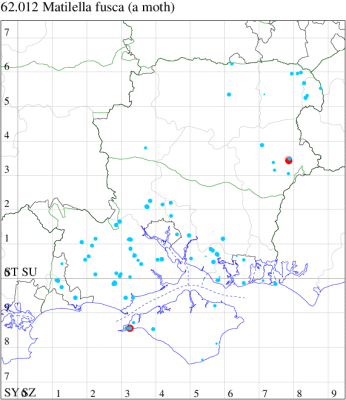
Records by year
Records by week (adult)
Records by week (larval)
Record Details
VC10: West High Down Quarry, one, 20 Aug (IOu);
VC12: Whitehill, one, to actinic, 27 May (ASto)
62.0151 [B&F: 1462a] Delplanqueia inscriptella (Duponchel, 1836) - Local
The species on the British list known as D. dilutella is now known to be two species, with the sister being D. inscriptella, due to differences in the genitalia of both sexes (Leraut (2001)) and the latter species was added to the British list in 2015 (D. Agassiz, Ent. Rec.127)
Old records in our region ascribed to dilutella are assumed to refer to inscriptella, with dilutella sensu stricto only having been confirmed from Cornwall, Ireland, the Isle of Man and Scotland; the mapped distribution reflects this assumption. Wingspan 18-23 mm.
All records of Deplanqueia dilutella must be confirmed by dissection to be acceptable.
Records prior to 2020
| Vice County | #Records | #Individuals | First Record | Last Record |
|---|---|---|---|---|
| 10 | 38 | 64 | 1900 | 2019 |
| 11 | 112 | 154 | 1951 | 2019 |
| 12 | 83 | 193 | 1951 | 2019 |
2020 records
| Vice County | #Records | #Individuals | Max Quantity |
|---|

Records by year
Records by week (adult)
Records by week (larval)
Record Details
VC11: Sway, one, 25 Jun (SKe)
62.021 [B&F: 1441] Oncocera semirubella (Scopoli, 1763) - Nationally Scarce B
Nationally scarce (Nb) on chalk downland and limestone cliffs in England, from Kent to Somerset and in Norfolk. On the Isle of Wight, occurs on the chalk downs, where known since the middle of the nineteenth century. First recorded in Hampshire in 1989, surprisingly in VC12 at Micheldever; since that time there have been very few inland records. Most records, however, are most likely to result from primary immigration from the continent. Wingspan 26-30 mm. Unmistakable. Larva feeds on Bird's-foot Trefoil, White Clover and Common Restharrow.
Records prior to 2020
| Vice County | #Records | #Individuals | First Record | Last Record |
|---|---|---|---|---|
| 10 | 127 | 513 | 1856 | 2019 |
| 11 | 67 | 65 | 1981 | 2019 |
| 12 | 8 | 8 | 1989 | 2018 |
2020 records
| Vice County | #Records | #Individuals | Max Quantity |
|---|---|---|---|
| 10 | 7 | 8 | 2 |
| 11 | 4 | 3 | 1 |
| 12 | 7 | 14 | 6 |

Records by year
Records by week (adult)
Records by week (larval)
Record Details
VC10: West High Down Quarry, one, 07 Aug; two, 20 Aug; Windy Corner, one, 14 Sep (IOu); Bonchurch, one, 13 Jul; one, 27 Aug (JHa); Shanklin, one, 06 Aug; Shanklin Upper Chine, one, 20 Aug (IOu);
VC11: Woodlands, New Forest, present, 12 Aug (RBW); Broughton*, one, to actinic, 06 Aug (GCE); Wickham Common*, one, 15 Sep (KC); Wickham*, one, 18 Jul (JRDS); Burton, nr Christchurch, one, 30 Jun (JSw);
VC12: Anna Valley, Andover*, one, 20 Jul (TJN); Barton Stacey*, two, to actinic, 25 Jun; two, to actinic, 16 Jul; six, to actinic, 25 Jun; one, to actinic, 11 Aug; one, to actinic, 16 Jul; one, to actinic, 16 Jul (GCE); Farnborough, one, 30 Jun (KBW)
62.022 [B&F: 1443] Pempelia genistella (Duponchel, 1836) - Nationally Scarce B
Nationally scarce (Nb) on heathland in southern England, from Sussex to Dorset, where predominantly coastal. In Hampshire and on the Isle of Wight almost exclusively recorded within a few miles of the coast, with a handful of records inland from the New Forest and the heaths in the north-east of the county. Wingspan 26-29 mm. Coloration more ochreous than in related species; black edging of cross-lines usually a prominent feature [Goater]. Larva feeds on Gorse, on which the larval webs are abundant in spring.
Records prior to 2020
| Vice County | #Records | #Individuals | First Record | Last Record |
|---|---|---|---|---|
| 10 | 65 | 46 | 1800 | 2019 |
| 11 | 507 | 1167 | 1800 | 2019 |
| 12 | 15 | 29 | 1981 | 2019 |
2020 records
| Vice County | #Records | #Individuals | Max Quantity |
|---|---|---|---|
| 10 | 7 | 9 | 3 |
| 11 | 17 | 19 | 3 |
| 12 | 4 | 4 | 1 |
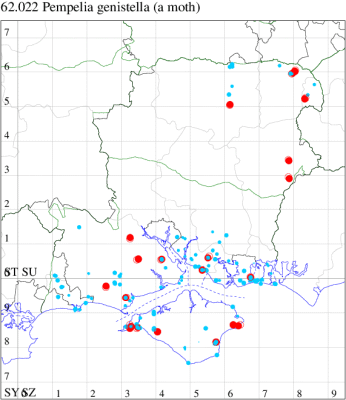
Records by year
Records by week (adult)
Records by week (larval)
Record Details
VC10: West High Down Quarry, one, 07 Aug (IOu); Totland, one, gen det, 26 Jul (SAK-J det. Colin Plant & Robin Knill-Jones); Freshwater Cliffs, one, 16 Jul (SDa); Mottistone Down*, larva, two, field observation, in web & larval tube on shoots of Ulex europaea, 16 Sep (PBa); Shanklin, one, 02 Aug; Bembridge Fort, three, 06 Aug (IOu); Whitecliff Bay, larva, present, field observation, several larval tubes and webbing, with larvae, in shoots of Ulex europaea, 01 Oct (PBa);
VC11: Shatterford, NF*, one, 14 Jul; present, 14 Jul (RBW, MWa); Woodlands, New Forest*, present, 17 Jun (RBW); Dibden Purlieu, one, to actinic, 23 Jun; one, to actinic, 24 Jun; two, to actinic, 25 Jun; one, to actinic, 26 Jul; two, to actinic, 31 Jul; one, to actinic, 14 Aug; one, to actinic, 15 Aug (RAC); Titchfield Haven NNR, one, 12 Jul (KC det. RJD); Catisfield, one, 23 Jun; one, to actinic, 25 Jun (ALR); Portsmouth, three, 26 Jun; one, 15 Jul (IRT); Sway, one, to actinic, 22 Jul (S&SL); Pennington, one, 10 Aug (RFC);
VC12: Basingstoke, one, 16 Jul; one, 23 Jul (RHil); Warren Hill, Liss Forest*, one, 25 Jul (RJM); Whitehill*, one, 23 Jul (ASto); Castle Bottom NNR, present, 25 Jun; Long Valley, Fleet, one, netted, 20 Jun (JHH, AMD); Yateley*, one, 07 Aug; one, 31 Jul (JHH)
62.023 [B&F: 1442] Pempelia palumbella ([Denis & Schiffermüller], 1775) - Local
Local on heathland throughout Britain, apart from northern Scotland. Fairly common in Hampshire in the New Forest and on the north-eastern heaths, but rather uncommon elsewhere in the county and on the Isle of Wight. Wingspan 22-28 mm. Recognised by the combination of plumbeous coloration, pale first line and small black scale-tuft [Goater]. Larva feeds on Heather, Heath Milkwort and Wild Thyme.
Records prior to 2020
| Vice County | #Records | #Individuals | First Record | Last Record |
|---|---|---|---|---|
| 10 | 29 | 27 | 1962 | 2019 |
| 11 | 329 | 426 | 1951 | 2019 |
| 12 | 73 | 71 | 1951 | 2019 |
2020 records
| Vice County | #Records | #Individuals | Max Quantity |
|---|---|---|---|
| 11 | 13 | 12 | 1 |
| 12 | 4 | 4 | 1 |

Records by year
Records by week (adult)
Records by week (larval)
Record Details
VC11: Brockwood, one, 19 Jun (SDut); Hale Purlieu, one, to actinic, 13 Aug (MCu); Denny Lodge, NF, present, 08 Sep (iNat); Shatterford, NF, one, 14 Jul (RBW, MWa); Woodlands, New Forest, present, 04 Jun (RBW); Totton, one, 15 Jun; one, 17 Aug (LH); Romsey, one, 02 Jun (SLay); Dibden Purlieu, one, to actinic, 15 Jun; one, to actinic, 20 Jun; one, to actinic, 23 Jun; one, to actinic, 24 Jun; one, to actinic, 25 Jun (RAC); Southampton, one, to UV, 18 Aug (JVet); Sway, one, 23 Jun; three, 24 Jun; two, 25 Jun (SKe);
VC12: Basingstoke*, one, 26 Jun (MJW); Silchester Common, one, 14 Jun (JLe); Warren Hill, Liss Forest, one, 27 Jun (RJM); Castle Bottom NNR, present, netted, 18 May (JHH); present, 25 Jun (JHH, AMD); Fleet, one, 06 Aug (AGi); Yateley*, one, 23 Jun (JHH)
62.024 [B&F: 1445] Rhodophaea formosa (Haworth, 1811) - Local
Local in hedgerows throughout much of south-east England. Distributed widely across Hampshire and the Isle of Wight, and apparently increasing again after the sharp decreases associated with Dutch Elm Disease. Wingspan 20-23 mm. This species can be recognised by the soft red and grey mottling of the forewing, and prominent median blotch. Larva feeds on Elm, living within a spun or rolled leaf, and over-wintering as a pupa.
Records prior to 2020
| Vice County | #Records | #Individuals | First Record | Last Record |
|---|---|---|---|---|
| 10 | 56 | 67 | 1800 | 2019 |
| 11 | 100 | 84 | 1800 | 2019 |
| 12 | 54 | 56 | 1951 | 2019 |
2020 records
| Vice County | #Records | #Individuals | Max Quantity |
|---|---|---|---|
| 10 | 4 | 9 | 3 |
| 11 | 2 | 3 | 2 |
| 12 | 3 | 3 | 1 |

Records by year
Records by week (adult)
Records by week (larval)
Record Details
VC10: Kingston, two, 24 Jun; one, 02 Jul; three, 16 Jul (ENes); Bonchurch*, three, 25 Jun (JHa);
VC11: Winchester, one, 17 Jul (THW); Northney, Hayling Island, present, 14 Jun; present, 15 Jun; present, 26 Jun; present, 01 Jul; present, 21 Aug (JWP); Burton, nr Christchurch, two, 23 Jul (JSw);
VC12: Cholderton, one, 17 Jul; one, 24 Jul (TJN, HE); Crawley, one, to actinic, 30 Jun; Barton Stacey, one, to actinic, photograph taken., 25 Jun (GCE); Cheriton, one, to actinic, 24 Jun (DAS)
62.025 [B&F: 1454b] Dioryctria sylvestrella (Ratzeburg, 1840) - Nationally Scarce B
Nationally scarce (Nb) in pine woodland in south-eastern England. In Hampshire and on the Isle of Wight widespread, but thinly distributed throughout much of the county, remaining very uncommon on the Island. Resident population probably increased by migration from the continent, particularly in 2006. Wingspan 28-35 mm. The genus Dioryctria contains four closely related species in Britain, which require close examination to separate: in D. sylvestrella the subterminal line is generally smooth with a single waved kink its mid-point, in the other three species this line is dentate from the mid-point to the dorsum. Larva feeds on Scots Pine, Maritime Pine and Corsican Pine.
Records prior to 2020
| Vice County | #Records | #Individuals | First Record | Last Record |
|---|---|---|---|---|
| 10 | 23 | 30 | 2003 | 2019 |
| 11 | 119 | 126 | 2000 | 2019 |
| 12 | 30 | 42 | 2005 | 2019 |
2020 records
| Vice County | #Records | #Individuals | Max Quantity |
|---|---|---|---|
| 10 | 4 | 4 | 1 |
| 11 | 9 | 7 | 1 |
| 12 | 4 | 4 | 1 |
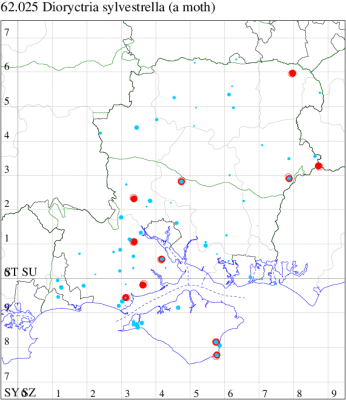
Records by year
Records by week (adult)
Records by week (larval)
Record Details
VC10: Bonchurch, one, 19 Jun; one, 24 Jun; one, 25 Jun (JHa); Shanklin, one, 25 Jun (IOu);
VC11: Ashurst, NF, one, 10 Aug; one, 18 Sep (SAB); Stanbrige Earls, one, to actinic, 22 Jul (JRMi); Dibden Purlieu, one, to actinic, 07 Aug; one, 04 Sep (RAC); Winchester, one, 17 Jul (THW); Wickham, one, 21 Jul; two, 22 Jul; one, 23 Jul; one, 05 Aug (JRDS); Pennington, one, 24 Jun (RFC); Norleywood, NF, present, 09 Aug (RBW, MWa);
VC12: Cholderton, one, 17 Jul (TJN, HE); Liss Forest, one, gen det, 27 Jun; Warren Hill, Liss Forest, one, gen det, 18 Jul; one, gen det, 25 Jul (RJM); Castle Bottom NNR*, present, 25 Jun (JHH, AMD); Hammer Vale, Woolmer, one, 24 Jul (ASw)
62.026 [B&F: 1454a] Dioryctria schuetzeella Fuchs, 1899 - Nationally Scarce B
Nationally scarce (Nb) in pine woodland in south-eastern England. Restricted to the New Forest, although there have been no reports in recent years. Scattered sightings elsewhere, including from Freshwater in 1985. Some of these, if not all, may not stand up to critical examination. Wingspan 26-28 mm. The genus Dioryctria contains four closely related species in Britain, which require close examination to separate: D. schuetzeella is the smallest and more contrasting of the four, with fascia and discal spot broader and whiter. Larva feeds on Norway Spruce, living between needles spun together with silk.
Records prior to 2020
| Vice County | #Records | #Individuals | First Record | Last Record |
|---|---|---|---|---|
| 10 | 2 | 1 | 1981 | 1985 |
| 11 | 9 | 6 | 1981 | 1999 |
| 12 | 4 | 3 | 1981 | 2006 |
2020 records
| Vice County | #Records | #Individuals | Max Quantity |
|---|---|---|---|
| 12 | 1 | 1 | 1 |

Records by year
Records by week (adult)
Records by week (larval)
Record Details
VC12: Warren Hill, Liss Forest*, one, gen det, 18 Jul (RJM)
62.027 [B&F: 1455] Dioryctria simplicella Heinemann, 1863 - Local
Local in pine woodland throughout much of England and Scotland. In Hampshire and on the Isle of Wight common where there is pine on heaths and plantations throughout the county, but distinctly uncommon on the Island. Wingspan 24-30 mm. The genus Dioryctria contains four closely related species in Britain, which require close examination to separate: D. simplicella is usually more uniformly grey in appearance than the other three species, exhibiting a reduction in contrast between the ground colour of the forewing and the paler cross-lines and discal spot. Larva feeds within young shoots of Scots Pine, Corsican Pine and Maritime Pine.
Records prior to 2020
| Vice County | #Records | #Individuals | First Record | Last Record |
|---|---|---|---|---|
| 10 | 3 | 0 | 1981 | 1995 |
| 11 | 181 | 164 | 1969 | 2019 |
| 12 | 75 | 81 | 1981 | 2019 |
2020 records
| Vice County | #Records | #Individuals | Max Quantity |
|---|---|---|---|
| 11 | 5 | 4 | 1 |
| 12 | 18 | 26 | 3 |
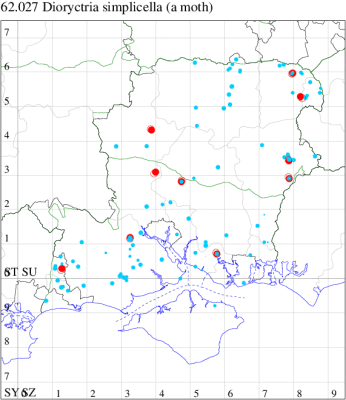
Records by year
Records by week (adult)
Records by week (larval)
Record Details
VC11: Brockwood, one, 04 Jul (SDut); Woodlands, New Forest, present, 24 Jun (RBW); Kings Somborne, one, to actinic, 15 Jun (GCE); Winchester, one, 31 Jul (THW); Fareham, one, ♂, gen det, 18 Jul (KJW det. RJD);
VC12: Harewood Forest*, one, to actinic, 24 Jun (GCE); Liss Forest, three, gen det, 27 Jun; Warren Hill, Liss Forest, one, gen det, 04 Jul; one, gen det, 18 Jul; one, 18 Jul; one, 18 Jul; Liss Forest, one, 25 Jul; three, 01 Aug; Warren Hill, Liss Forest, one, 05 Sep (RJM); Whitehill, one, to actinic, 21 May; two, to actinic, 04 Jul; two, to actinic, 07 Jul; two, to actinic, 24 Jul; one, to actinic, 18 Aug; one, to actinic, 21 Aug; one, 11 Sep; one, 14 Sep (ASto); Castle Bottom NNR, present, 25 Jun (JHH, AMD); one, to actinic, 16 Aug (JHH); Fleet, two, 06 Aug (AGi)
62.028 [B&F: 1454] Dioryctria abietella ([Denis & Schiffermüller], 1775) - Common
Common in pine woodland throughout southern England, also appearing as a migrant from mainland Europe away from the vicinity of pines. In Hampshire and on the Isle of Wight closely associated with Scots Pine, and fairly common in the county. Wingspan 27-33 mm. The genus Dioryctria contains four closely related species in Britain, which require close examination to separate: D. abietella is most likely to be confused with D. sylvestrella, which see for a description of the differences. Larva feeds within young shoots of Scots Pine, Norway Spruce and European Larch.
Records prior to 2020
| Vice County | #Records | #Individuals | First Record | Last Record |
|---|---|---|---|---|
| 10 | 45 | 47 | 1937 | 2019 |
| 11 | 463 | 478 | 1951 | 2019 |
| 12 | 122 | 101 | 1951 | 2019 |
2020 records
| Vice County | #Records | #Individuals | Max Quantity |
|---|---|---|---|
| 10 | 4 | 4 | 1 |
| 11 | 7 | 7 | 1 |
| 12 | 5 | 5 | 1 |

Records by year
Records by week (adult)
Records by week (larval)
Record Details
VC10: Freshwater, one, to actinic, 19 Sep (PBa); Kingston, one, 16 Jul (ENes); Bonchurch, one, 07 Jun (JHa); Shanklin, one, gen det, 09 Jun (IOu);
VC11: Brockwood, one, 23 May (SDut); Kings Somborne, one, to actinic, 23 Jun; one, to actinic, 11 Jun (GCE); Dibden Purlieu, one, to actinic, 18 Jul; one, to actinic, 31 Jul; one, to actinic, 05 Aug; one, to actinic, 07 Aug (RAC); Northney, Hayling Island, present, 13 Jul (JWP); Sway, one, 11 Jun; one, 24 Jun (SKe);
VC12: Cholderton, one, 24 Jul; two, 31 Jul (TJN, HE); Basingstoke, one, 23 Jun; one, 26 Jun (MJW); one, 16 Jul (RHil); Liss, one, 31 Jul (LBe); Whitehill, one, to actinic, 16 Jul (ASto)
62.029 [B&F: 1452] Phycita roborella ([Denis & Schiffermüller], 1775) - Common
Common in oak woodland, deciduous woodland and areas with scattered trees throughout much of England; rare in Ireland. In Hampshire and on the Isle of Wight the commonest phycitine throughout much of the region, and one of the easiest to identify. Wingspan 24-29 mm. Easily recognised by the reddish admixture of the forewing, together with the broadly triangular dark patch before first line [Goater]. Larva feeds on Oak, living between leaves spun together with silk.
Records prior to 2020
| Vice County | #Records | #Individuals | First Record | Last Record |
|---|---|---|---|---|
| 10 | 162 | 266 | 1856 | 2019 |
| 11 | 2875 | 5017 | 1951 | 2019 |
| 12 | 1031 | 2972 | 1951 | 2019 |
2020 records
| Vice County | #Records | #Individuals | Max Quantity |
|---|---|---|---|
| 10 | 8 | 13 | 5 |
| 11 | 53 | 56 | 2 |
| 12 | 59 | 169 | 45 |

Records by year
Records by week (adult)
Records by week (larval)
Record Summary
VC10: Earliest: Bonchurch, 11 Jun, 1 (JHa) Latest: Cranmore, 25 Jul, 0 (CHic) Max count: Firestone Copse, 21 Jul, 5 (IOu)
VC11: Earliest: Botley, 13 Jun, 1 (SLB) Latest: Pennington, 19 Sep, 1 (RFC) Max count: Southampton, 12 Aug, 3 (MEdg)
VC12: Earliest: Pamber Forest, 17 Jun, 1 (GJD) Latest: Whitehill, 11 Sep, 1 (ASto) Max count: Pamber Forest, 31 Jul, 45 (GJD)
62.032 [B&F: 1465] Nephopterix angustella (Hübner, 1796) - Local
Local and increasing in hedgerows, scrub and gardens throughout southern England. In Hampshire and on the Isle of Wight numbers recorded on the county database have increased significantly since the mid 1990s, with an average of five annual records between 1995 and 2002, increasing to more than 20 annual records between 2003 and 2005, and an unprecedented 80 in 2006: this was a good year for migrants, and it is certain that the resident population is strengthened by arrivals from the continent at times. Wingspan 20-25 mm. The bar of blackish raised scales from dorsum to shortly beyond middle of wing render the species unmistakable [Goater]. Larva feeds within berries of Spindle, perhaps increasingly making use of garden forms, such as Euonymus japonicus, over-wintering as a pupa.
Records prior to 2020
| Vice County | #Records | #Individuals | First Record | Last Record |
|---|---|---|---|---|
| 10 | 76 | 51 | 1900 | 2019 |
| 11 | 388 | 379 | 1951 | 2019 |
| 12 | 212 | 253 | 1951 | 2019 |
2020 records
| Vice County | #Records | #Individuals | Max Quantity |
|---|---|---|---|
| 10 | 19 | 14 | 2 |
| 11 | 21 | 20 | 1 |
| 12 | 5 | 5 | 1 |
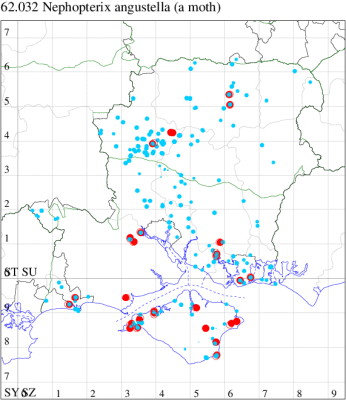
Records by year
Records by week (adult)
Records by week (larval)
Record Details
VC10: West High Down Quarry, two, 20 Aug (IOu); Tennyson Down, larval feeding signs, present, field observation, larval webbing and feeding signs on fruits of Euonymus europaeus, 25 Sep (PBa); Totland, one, 20 Sep (RTe); Freshwater Cliffs, one, 09 Aug; one, 08 Sep (SDa); Freshwater, larval feeding signs, present, field observation, larval webs and feeding signs on fruit of Euonymus europaeus, 22 Sep; Ningwood Common, larval feeding signs, present, field observation, larval webs and feeding signs on fruits of Euonymus europaeus, 23 Sep; Cranmore, larval feeding signs, present, field observation, larval webs and feeding signs on seed heads of Euonymus europaeus, 23 Sep (PBa); Bonchurch, one, 07 Jun; one, 08 Jun; one, 11 Jun (JHa); Haseley Manor, one, gen det, 06 Jul; Shanklin, one, 02 Jun; one, 14 Aug; one, 14 Sep; two, 15 Sep (IOu); Binfield, larval feeding signs, present, field observation, larval workings on fruits of Euonymus europaeus, 13 Sep; Brading*, larval feeding signs, present, field observation, larval webs and feeding signs on fruits of Euonymus europaeus, 19 Sep; Bembridge Marsh*, larval feeding signs, present, field observation, larval webs and feeding signs on fruits of Euonymus europaeus, 19 Sep (PBa);
VC11: Woodlands, New Forest, present, 11 Aug (RBW); Ashurst, NF, one, 08 Aug; one, 10 Aug; one, 15 Sep; one, 22 Sep (SAB); Totton, one, 21 May; one, 28 May; one, 02 Jun; one, 07 Aug; one, 11 Aug (LH); Fareham, one, to actinic, 30 May; one, to actinic, 13 Jun (MLO); one, 16 Aug (KJW); Wickham Common, one, 14 Aug (KC); Portsmouth, one, 03 Aug (IRT); Tuckton, Bournemouth, one, 09 Aug (APar); Burton, nr Christchurch, one, 09 Jun; one, 11 Aug; one, 13 Aug (JSw); Pennington, one, 08 Aug (RFC); Southsea, one, 26 Jun (JGe);
VC12: Chilbolton, one, to actinic, 28 Jul (GCE); Anna Valley, Andover, one, 21 May; one, 02 Jun; one, 23 Jun (TJN); Barton Stacey, one, to actinic, 11 Aug; one, to actinic, 08 Jun (GCE); Basingstoke, one, 01 Jun (MJW); one, 31 Jul (RHil)
62.033 [B&F: 1435] Acrobasis tumidana ([Denis & Schiffermüller], 1775) - Migrant
Immigrant from mainland Europe to southern England, with records north to Lancashire. In Hampshire and on the Isle of Wight barely annual, except in 2004 when five were recorded, all in the first half of August. Wingspan 19-24 mm. Forewing markings similar to those of C. repandana, but differs in having a ridge of reddish, raised scales distal to first line [Goater]. Larva feeds on Oak, living within a spun or rolled leaf.
Records prior to 2020
| Vice County | #Records | #Individuals | First Record | Last Record |
|---|---|---|---|---|
| 10 | 9 | 13 | 1873 | 2019 |
| 11 | 28 | 26 | 1981 | 2019 |
| 12 | 3 | 3 | 2012 | 2019 |
2020 records
| Vice County | #Records | #Individuals | Max Quantity |
|---|---|---|---|
| 10 | 2 | 2 | 1 |
| 11 | 4 | 3 | 1 |

Records by year
Records by week (adult)
Records by week (larval)
Record Details
VC10: Shanklin, one, 09 Aug; Shanklin Upper Chine, one, 31 Jul (IOu);
VC11: Woodlands, New Forest*, present, 11 Aug (RBW); Sholing, Southampton*, one, new to garden, 15 Aug (ARC); Hill Head, one, 08 Aug (ZCa); Fareham, one, to actinic, 11 Aug (MLO); Portsmouth, one, 31 Jul (IRT);
VC12: Alton*, one, to actinic, photo requested, 11 Aug (NDP)
62.034 [B&F: 1436] Acrobasis repandana (Fabricius, 1798) - Common
Common in oak and other deciduous woodland and areas with scattered oak-trees throughout England. In Hampshire and on the Isle of Wight fairly frequent in old oak woodland, scarce away from that biotope. Wingspan 20-25 mm. Forewing markings similar to those of C. tumidana, but C. tumidana differs in having a ridge of reddish, raised scales distal to first line, another cluster of such scales at base of wing, and more indistinct, wavy second line [Goater]. Larva feeds on Oak, living between leaves spun together with silk, often high in the canopy.
Records prior to 2020
| Vice County | #Records | #Individuals | First Record | Last Record |
|---|---|---|---|---|
| 10 | 39 | 61 | 1981 | 2019 |
| 11 | 307 | 306 | 1951 | 2019 |
| 12 | 209 | 671 | 1951 | 2019 |
2020 records
| Vice County | #Records | #Individuals | Max Quantity |
|---|---|---|---|
| 10 | 27 | 235 | 85 |
| 11 | 29 | 53 | 5 |
| 12 | 9 | 17 | 7 |
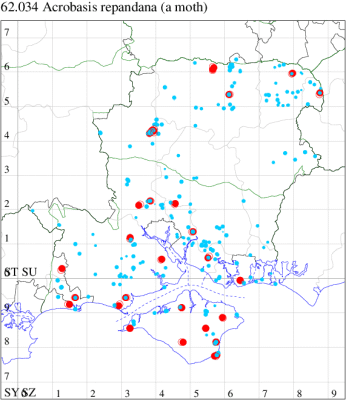
Records by year
Records by week (adult)
Records by week (larval)
Record Details
VC10: West High Down Quarry, one, 07 Aug (IOu); Kingston*, one, 24 Jun (ENes); Parkhurst Forest, one, 29 Jun (IOu); Wheelers Bay, one, 08 Aug (ABu); Bonchurch, 33, 24 Jun; 49, 25 Jun; two, 12 Jul; three, 13 Jul (JHa); Haseley Manor, one, 06 Jul; Shanklin, 31, 24 Jun; 85, 25 Jun; one, 26 Jun; one, 05 Jul; two, 06 Jul; two, 07 Jul; two, 08 Jul; one, 14 Jul; three, 16 Jul; one, 17 Jul; four, 20 Jul; one, 22 Jul; one, 08 Aug; two, 09 Aug; one, 13 Aug; one, 14 Aug; one, 18 Aug (IOu); Broadley Copse, three, to actinic, 25 Jun (JBa);
VC11: Brockwood, one, 04 Jul (SDut); Woodlands, New Forest, present, 24 Jun (RBW); Romsey, one, 24 Jun (SC); four, 25 Jun (NRJ); Dibden Purlieu, three, to actinic, 25 Jun; one, to actinic, 09 Aug (RAC); Allbrook, one, 23 Jun; two, to actinic, 25 Jun; one, 30 Jul (SI); Catisfield, one, 15 Jun; four, to actinic, 25 Jun (ALR); Botley, one, to actinic, 25 Jun (SLB); Wickham, one, 28 Jun; one, 29 Jun (JRDS); Tuckton, Bournemouth, one, 25 Jun (APar); Burton, nr Christchurch, three, 09 Jun; three, 07 Jul (JSw); Sway, one, 24 Jun; two, 29 Jun; one, 01 Jul (SKe); Milford on Sea, one, 25 Jun; one, 17 Jul (MMcM); Pennington, two, 29 May; five, 02 Jun; one, 24 Jun; one, 13 Aug (RFC); Southsea, four, 25 Jun; one, 26 Jun; one, 17 Jul; one, 01 Aug (JGe);
VC12: Goodworth Clatford, one, to actinic, 23 Jul; Harewood Forest, three, to actinic, 24 Jun; one, to actinic, 24 Jun; one, to actinic, 24 Jun; one, to actinic, 23 Jul (GCE); Axmansford, one, 23 Jul; seven, 13 Jul (ACB); Basingstoke, one, 26 Jun (MJW); Castle Bottom NNR, present, 25 Jun (JHH, AMD); Farnborough, one, 14 Jul (KBW)
62.035 [B&F: 1439] Acrobasis advenella (Zincken, 1818) - Common
Common in hedgerows and gardens throughout Britain, except the far north. Widespread and common in Hampshire and on the Isle of Wight. Wingspan 19-24 mm. Similar to, but usually smaller than, T. suavella. Larva feeds on Blackthorn and Rowan, living between flowers and leaves spun together with silk.
Records prior to 2020
| Vice County | #Records | #Individuals | First Record | Last Record |
|---|---|---|---|---|
| 10 | 119 | 180 | 1889 | 2019 |
| 11 | 2626 | 3684 | 1951 | 2019 |
| 12 | 754 | 1154 | 1951 | 2019 |
2020 records
| Vice County | #Records | #Individuals | Max Quantity |
|---|---|---|---|
| 10 | 1 | 0 | 0 |
| 11 | 89 | 129 | 5 |
| 12 | 36 | 60 | 4 |

Records by year
Records by week (adult)
Records by week (larval)
Record Summary
VC10: Earliest: Cranmore, 09 Aug, 0 (CHic) Max count: Cranmore, 09 Aug, 0 (CHic)
VC11: Earliest: Totton, 09 Jun, 1 (LH) Latest: Totton, 23 Aug, 1 (LH) Max count: Ashurst, NF, 12 Aug, 5 (SAB)
VC12: Earliest: Basingstoke, 24 Jun, 1 (MJW) Latest: Whitehill, 21 Aug, 1 (ASto) Max count: Barton Stacey, 11 Aug, 4 (GCE)
62.036 [B&F: 1438] Acrobasis suavella (Zincken, 1818) - Local
Local in hedgerows and scrub throughout southern England. Wingspan 23-25 mm. Widespread and fairly common in Hampshire and on the Isle of Wight. Similar to, but larger than, T. advenella. Larva feeds on Blackthorn and Hawthorn, living within a silken gallery between the leaves.
Records prior to 2020
| Vice County | #Records | #Individuals | First Record | Last Record |
|---|---|---|---|---|
| 10 | 151 | 188 | 1856 | 2019 |
| 11 | 631 | 605 | 1951 | 2019 |
| 12 | 219 | 258 | 1951 | 2019 |
2020 records
| Vice County | #Records | #Individuals | Max Quantity |
|---|---|---|---|
| 10 | 30 | 77 | 10 |
| 11 | 25 | 25 | 2 |
| 12 | 15 | 15 | 1 |

Records by year
Records by week (adult)
Records by week (larval)
Record Details
VC10: West High Down Quarry, one, 20 Aug (IOu); Bonchurch, one, 25 Jun (JHa); Haseley Manor, five, 11 Aug; Shanklin, one, 13 Jun; one, 15 Jun; one, 22 Jun; two, 24 Jun; three, 25 Jun; one, 01 Jul; one, 07 Jul; two, 12 Jul; one, 17 Jul; one, 20 Jul; four, 22 Jul; two, 26 Jul; one, 29 Jul; two, 30 Jul; two, 03 Aug; one, 05 Aug; three, 06 Aug; one, 07 Aug; 10, 08 Aug; nine, 09 Aug; three, 11 Aug; four, 13 Aug; six, 14 Aug; one, 20 Aug; two, 23 Aug; Shanklin Upper Chine, three, 08 Aug; Firestone Copse, two, 21 Jul (IOu);
VC11: Brockwood, one, 14 Aug (SDut); Woodlands, New Forest, present, 31 May (RBW); Ashurst, NF, one, 06 Aug (SAB); Lee, one, 18 Jul (CTh); East Tytherley, one, to actinic, 10 Aug; one, to actinic, 10 Aug (GCE); Romsey, one, 16 Jul; two, 18 Jul; one, 08 Aug (MB); Ashley, one, to actinic, 22 Jul; Kings Somborne, one, to actinic, 07 Aug; one, to actinic, 15 Jul (GCE); Southampton, one, 07 May (MEdg); Eastleigh, one, to actinic, 01 Jul; one, to actinic, 02 Jul (KArb); Kings Somborne, one, to actinic, 15 Jul (GCE); Teg Down, one, to actinic, 03 Aug (EmPe); Fareham, one, 21 Jul; one, 31 Jul; one, 07 Aug (IMcP); one, to actinic, 23 Jul (MLO); one, 09 Jul (KJW); Botley, one, to actinic, 31 Jul; one, to actinic, 04 Aug (SLB); Tuckton, Bournemouth, one, 09 Jul; one, 15 Jul; one, 06 Aug (APar); Burton, nr Christchurch, one, 07 Jul (JSw); Sway, two, 23 Jun; one, 29 Jun; one, 29 Jun (SKe);
VC12: Cholderton, one, 24 Jul (TJN, HE); Anna Valley, Andover, two, 25 Jun; one, 20 Jul (TJN); Wherwell, one, to actinic, 29 Jun; one, to actinic, 29 Jun; one, to actinic, 29 Jul; Harewood Forest, one, to actinic, 23 Jul; Crawley, one, to actinic, 21 Jul; one, to actinic, 30 Jun (GCE); Harestock, one, to actinic, 17 Jul (GRog); Barton Stacey, one, to actinic, 08 Jun; one, to actinic, 08 Jun; one, to actinic, 16 Jul; one, to actinic, photograph taken., 08 Jun; one, to actinic, 16 Jul; one, to actinic, 16 Jul; one, to actinic, 22 Jun (GCE); Cheriton*, one, to actinic, 31 Jul (DAS); Whitehill, one, to actinic, 24 Jul (ASto)
62.037 [B&F: 1440] Acrobasis marmorea (Haworth, 1811) - Local
Local in hedgerows and scrub throughout England and Wales, more numerous in the south. Fairly widespread in southern Hampshire, but remaining distinctly scarce in northern Hampshire and on the Isle of Wight. Wingspan 18-23 mm. Has shorter, blunter forewing than other British Trachycera, and costa is straighter [Goater]. Larva feeds on Blackthorn and Hawthorn, living within a silken tube or tent.
Records prior to 2020
| Vice County | #Records | #Individuals | First Record | Last Record |
|---|---|---|---|---|
| 10 | 73 | 67 | 1856 | 2019 |
| 11 | 368 | 423 | 1951 | 2019 |
| 12 | 44 | 29 | 1951 | 2019 |
2020 records
| Vice County | #Records | #Individuals | Max Quantity |
|---|---|---|---|
| 10 | 7 | 8 | 2 |
| 11 | 22 | 29 | 4 |
| 12 | 3 | 5 | 3 |

Records by year
Records by week (adult)
Records by week (larval)
Record Details
VC10: Kingston, one, 01 Jul; one, 02 Jul; one, 06 Jul; two, 16 Jul; one, 19 Jul (ENes); Rookley, one, to actinic, 10 Jul (JBa); Shanklin, one, 25 Jun (IOu);
VC11: Matley Wood, NF, present, 05 Aug (RBW, MWa); Woodlands, New Forest, present, 04 Jun (RBW); Totton, one, 30 Jun (LH); Titchfield Haven NNR, four, 17 Jul (F.M.G.); Fareham, one, to actinic, 30 Jul; one, to actinic, 08 Aug (MLO); Portsmouth, one, 21 Jun; three, 25 Jun; one, 11 Jul (IRT); Tuckton, Bournemouth, one, 15 Jul; one, 10 Aug (APar); Burton, nr Christchurch, one, 09 Jun; one, 30 Jun; one, 04 Jul; one, 07 Jul; one, 23 Jul; one, 29 Jul (JSw); Sway, two, 25 Jun (SKe); Pennington, three, 24 Jun; one, 31 Jul; two, 08 Aug; two, 10 Aug; one, 17 Aug (RFC);
VC12: Barton Stacey, one, to actinic, 25 Jun; one, to actinic, 25 Jun; three, to actinic, 25 Jun (GCE)
62.038 [B&F: 1437] Acrobasis consociella (Hübner, [1813]) - Local
Local in oak and other deciduous woodland and areas with scattered oak-trees throughout most of the British Isles, but not in northern Scotland. In Hampshire and on the Isle of Wight widely distributed and fairly common. Wingspan 19-22 mm. A greyer species than Conobathra repandana or C. tumidana, differing particularly in the greyer basal area of the forewing, which is distinctly reddish in the Conobathra, although in some parts of the country, the median and outer parts of the wing are purplish or crimson, the basal area is always grey [Goater]. Larva feeds on Oak, living gregariously within spun or rolled leaves.
Records prior to 2020
| Vice County | #Records | #Individuals | First Record | Last Record |
|---|---|---|---|---|
| 10 | 64 | 67 | 1850 | 2019 |
| 11 | 426 | 374 | 1951 | 2019 |
| 12 | 162 | 169 | 1951 | 2019 |
2020 records
| Vice County | #Records | #Individuals | Max Quantity |
|---|---|---|---|
| 10 | 2 | 3 | 2 |
| 11 | 26 | 28 | 2 |
| 12 | 13 | 13 | 1 |
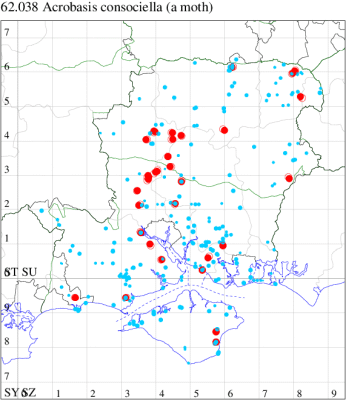
Records by year
Records by week (adult)
Records by week (larval)
Record Details
VC10: Shanklin, one, 03 Aug; Borthwood Copse, Winford, two, 23 Jun (IOu);
VC11: Marchwood, one, 20 Jun (CTh); Totton, one, 23 Jun; one, 20 Jul; one, 08 Aug; one, 10 Aug (LH); Timsbury, one, 12 Jul (TRa); Romsey, two, 25 Jun (SC); Ashley, one, to actinic, 22 Sep; Kings Somborne, one, to actinic, 09 Jul; one, to actinic, 31 Jul; one, to actinic, 22 Jul; one, to actinic, 15 Jun; one, to actinic, 15 Jul (GCE); Dibden Purlieu, one, 19 Sep (RAC); Allbrook, one, 07 Jul; one, 06 Aug (SI); Winchester, one, 31 Jul (THW); Kings Somborne, one, to actinic, 15 Jun; two, to actinic, 15 Jul (GCE); Titchfield Haven NNR, one, 17 Jul (F.M.G. det. RJD); Catisfield, one, 15 Jun (ALR); Wickham, one, 07 Aug (F.M.G.); one, 16 Jul; one, 17 Jul; one, 18 Jul (JRDS); Burton, nr Christchurch, one, 02 Jun (JSw); Pennington, one, 07 Aug (RFC);
VC12: Cholderton, one, 17 Jul (TJN, HE); Wherwell, one, to actinic, 29 Jul; Harewood Forest, one, to actinic, 23 Jul; one, to actinic, 23 Jul; Crawley, one, to actinic, 21 Jul; one, to actinic, 09 Jun; Barton Stacey, one, to actinic, 16 Jul; one, to actinic, 12 Jul; Wonston , one, to actinic, 17 Jul (GCE); Preston Candover, one, 12 Jul (MJW); Pamber Forest, one, 13 Jul; one, 31 Jul (GJD); Warren Hill, Liss Forest, one, 27 Jun (RJM); Castle Bottom NNR, present, 25 Jun (JHH, AMD); Fleet, one, 06 Aug (AGi); Yateley*, one, to actinic, 31 Jul; one, 23 Jun; one, 08 Aug (JHH)
62.039 [B&F: 1486] Apomyelois bistriatella (Hulst, 1887) - Nb
Nationally scarce (Nb) on burnt areas in heathland throughout southern England, but erratically and in mobile colonies. in Hampshire, found on the heaths of the New Forest and in the north-east, and an occasional wanderer elsewhere; recently recorded at Totland on the Isle of Wight. Wingspan 18-25 mm. The main confusion species are Pyla fusca and Ortholepis betulae, which see. Larva feeds on the fungus Daldinia concentrica growing on Birch and Gorse
Records prior to 2020
| Vice County | #Records | #Individuals | First Record | Last Record |
|---|---|---|---|---|
| 10 | 6 | 9 | 1929 | 2012 |
| 11 | 78 | 65 | 1931 | 2018 |
| 12 | 24 | 13 | 1951 | 2016 |
2020 records
| Vice County | #Records | #Individuals | Max Quantity |
|---|---|---|---|
| 11 | 1 | 1 | 1 |

Records by year
Records by week (adult)
Records by week (larval)
Record Details
VC11: Totton, one, 01 Jun (LH)
62.042 [B&F: 1458] Thistle Ermine Myelois circumvoluta (Fourcroy, 1785) - Common
Common on rough ground and chalk downland throughout southern Britain. Widespread and common in Hampshire and the Isle of Wight. Wingspan 27-33 mm. Considerable larger than the superficially similar Yponomeuta, and with fewer and larger black spots, with Y. sedella perhaps the closest match in pattern. Larva feeds on flowers and stems of Greater Burdock.
Records prior to 2020
| Vice County | #Records | #Individuals | First Record | Last Record |
|---|---|---|---|---|
| 10 | 181 | 227 | 1856 | 2019 |
| 11 | 995 | 1260 | 1951 | 2019 |
| 12 | 359 | 345 | 1951 | 2019 |
2020 records
| Vice County | #Records | #Individuals | Max Quantity |
|---|---|---|---|
| 10 | 16 | 18 | 2 |
| 11 | 23 | 24 | 2 |
| 12 | 17 | 20 | 2 |
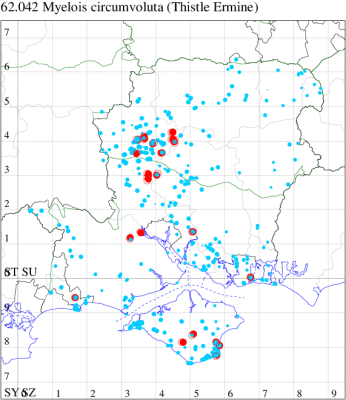
Records by year
Records by week (adult)
Records by week (larval)
Record Details
VC10: Kingston, two, 22 Jun; one, 24 Jun; one, 28 Jun; one, 16 Jul (ENes); Bonchurch, one, 25 May; one, 26 May; one, 27 May; one, 29 May; two, 30 May; one, 08 Jun; one, 11 Jun; one, 15 Jun; one, 24 Jun (JHa); Rookley, one, to actinic, 22 Jun (JBa); Shanklin, one, 25 Jun; Shanklin Upper Chine, one, 02 Jun (IOu);
VC11: Woodlands, New Forest, present, 29 May (RBW); Totton, one, 13 Jun (LH); Kings Somborne, one, to actinic, 09 Jul; Ashley, one, to actinic, 23 Jun; one, to actinic, 23 Jun; one, to actinic, 15 Jun (GCE); Botley, one, to actinic, 06 Jul; one, to actinic, 30 May; two, to actinic, 02 Jun; one, to actinic, 11 Jun; one, to actinic, 13 Jun; one, to actinic, 15 Jun; one, to actinic, 16 Jun; one, to actinic, 21 Jun; one, to actinic, 22 Jun; one, to actinic, 23 Jun; one, to actinic, 07 Jul (SLB); Portsmouth, one, 01 Jun; two, 25 Jun; one, 10 Jul (IRT); Northney, Hayling Island, present, 21 Jun; present, 01 Jul (JWP); Burton, nr Christchurch, one, 21 May; one, 29 May; one, 17 Jul (JSw); Sway, one, 27 May; one, 25 Jun (SKe);
VC12: Longstock, two, to actinic, 29 May; Chilbolton, one, to actinic, 01 Jun; one, to actinic, 07 Jun; Goodworth Clatford, two, to actinic, 30 May; one, to actinic, 30 May; one, to actinic, 30 May; Wherwell, one, to actinic, 13 Jun; one, to actinic, 13 Jun; two, to actinic, 13 Jun; Chilbolton, one, to actinic, 16 Jun; one, to actinic, 16 Jun; Barton Stacey, one, to actinic, 27 May; one, to actinic, 27 May; one, to actinic, 16 Jul; one, to actinic, 08 Jun; one, to actinic, 27 May; one, to actinic, 27 May (GCE)
62.043 [B&F: 1464] Gymnancyla canella ([Denis & Schiffermüller], 1775) - Nationally Scarce A
Nationally scarce (Na) on sandy beaches by the sea from Sussex to Dorset. In Hampshire and on the Isle of Wight the foodplant is local and uncommon and the moth has occurred only sporadically along the Solent coast of both counties, in the Christchurch area, Pennington, Freshwater, St Helens and Hayling. Wingspan 22-25 mm. This species bears some resemblance to a Homoeosoma or Phycitodes, but may be distinguished at once by the long, porrected labial palpi which in the other genera are shorter and ascending [Goater]. Larva feeds within stems of Prickly Saltwort, over-wintering as a pupa.
Records prior to 2020
| Vice County | #Records | #Individuals | First Record | Last Record |
|---|---|---|---|---|
| 10 | 4 | 4 | 1955 | 1995 |
| 11 | 5 | 3 | 1981 | 2013 |
2020 records
| Vice County | #Records | #Individuals | Max Quantity |
|---|---|---|---|
| 11 | 1 | 1 | 1 |

Records by year
Records by week (adult)
Records by week (larval)
Record Details
VC11: Tuckton, Bournemouth, one, not verified, 14 Jun (APar)
62.047 [B&F: 1461] Assara terebrella (Zincken, 1818) - Nationally Scarce A
Nationally scarce (Na) in coniferous woodland and plantations throughout much of southern England. In Hampshire a rather elusive species in stands of Norway Spruce, mainly in the New Forest, which continues to be recorded annually in very small numbers; very rare on the Isle of Wight. Wingspan 22-25 mm. Larva feeds within cones of Norway Spruce, causing sufficient damage to be a serious pest in some areas.
Records prior to 2020
| Vice County | #Records | #Individuals | First Record | Last Record |
|---|---|---|---|---|
| 10 | 4 | 4 | 2003 | 2015 |
| 11 | 65 | 52 | 1950 | 2019 |
| 12 | 27 | 28 | 1951 | 2019 |
2020 records
| Vice County | #Records | #Individuals | Max Quantity |
|---|
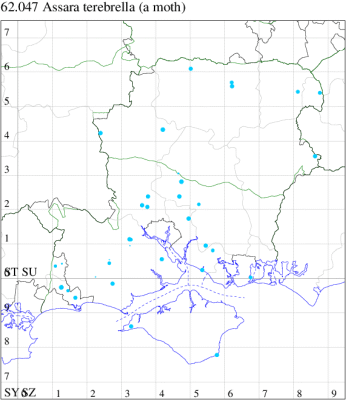
Records by year
Records by week (adult)
Records by week (larval)
Record Details
VC11: Sholing, Southampton, one, new to garden, 13 Aug (ARC)
62.048 [B&F: 1470] Euzophera pinguis (Haworth, 1811) - Common
Common in woodland and hedgerows throughout much of southern England. in Hampshire and on the Isle of Wight, widespread throughout, although seldom more than a few individuals are recorded from any locality. Wingspan 23-28 mm. The irregular transverse banding of ochreous and black on forewing makes this an easy species to identify [Goater]. Larva feeds within bark of Ash, eventually killing the tree if present in sufficient numbers.
Records prior to 2020
| Vice County | #Records | #Individuals | First Record | Last Record |
|---|---|---|---|---|
| 10 | 141 | 171 | 1900 | 2019 |
| 11 | 1995 | 2261 | 1951 | 2019 |
| 12 | 564 | 708 | 1951 | 2019 |
2020 records
| Vice County | #Records | #Individuals | Max Quantity |
|---|---|---|---|
| 10 | 26 | 56 | 8 |
| 11 | 178 | 259 | 7 |
| 12 | 34 | 41 | 3 |

Records by year
Records by week (adult)
Records by week (larval)
Record Summary
VC10: Earliest: Shanklin, 08 Jun, 1 (IOu) Latest: Shanklin Upper Chine, 20 Aug, 1 (IOu) Max count: West High Down Quarry, 07 Aug, 8 (IOu)
VC11: Earliest: Ashurst, NF, 27 May, 2 (SAB) Latest: Tuckton, Bournemouth, 08 Sep, 1 (APar) Max count: West Meon, 31 Jul, 7 (F.M.G.)
VC12: Earliest: Basingstoke, 26 May, 2 (RHil) Latest: Crawley, 26 Aug, 1 (GCE) Max count: Cholderton, 17 Jul, 8 (TJN, HE)
62.053 [B&F: 1467] Ancylosis oblitella (Zeller, 1848) - Nationally Scarce B
Nationally scarce (Nb) on saltmarshes and waste ground in parts of south-eastern England. In Hampshire and on the Isle of Wight most records are from near the coast and east of Southampton, with a scattering inland in the county and on the Island. Wingspan 18-22 mm. Most easily recognised by the presence of dark blotch on dorsum basal to first line, and pale, dentate cross-lines [Goater]. Larva feeds on Orache and Goosefoot.
Records prior to 2020
| Vice County | #Records | #Individuals | First Record | Last Record |
|---|---|---|---|---|
| 10 | 29 | 26 | 1874 | 2007 |
| 11 | 64 | 65 | 1951 | 2017 |
| 12 | 9 | 5 | 1951 | 2009 |
2020 records
| Vice County | #Records | #Individuals | Max Quantity |
|---|---|---|---|
| 10 | 2 | 2 | 1 |
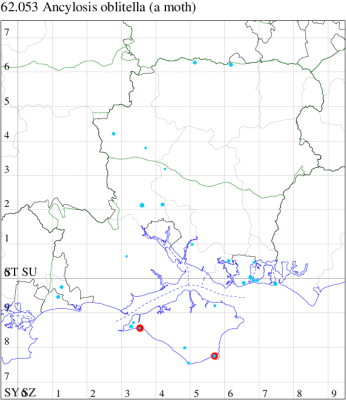
Records by year
Records by week (adult)
Records by week (larval)
Record Details
VC10: Freshwater Bay, one, to actinic, gen det, 17 Sep (PBa); Wheelers Bay, one, 16 Sep (ABu)
62.054 [B&F: 1481] Homoeosoma sinuella (Fabricius, 1794) - Common
Common in dry open areas, calcareous grassland, sand-dunes, waste ground and embankments throughout southern England and south Wales. Widespread and common in Hampshire and on the Isle of Wight. Wingspan 18-23 mm. An unmistakable species characterised by the ochreous, dark-banded forewing [Goater]. Larva feeds within roots of Greater and Ribwort Plantain.
Records prior to 2020
| Vice County | #Records | #Individuals | First Record | Last Record |
|---|---|---|---|---|
| 10 | 136 | 182 | 1973 | 2019 |
| 11 | 992 | 1294 | 1951 | 2019 |
| 12 | 256 | 338 | 1951 | 2019 |
2020 records
| Vice County | #Records | #Individuals | Max Quantity |
|---|---|---|---|
| 10 | 29 | 49 | 4 |
| 11 | 93 | 126 | 4 |
| 12 | 27 | 39 | 6 |
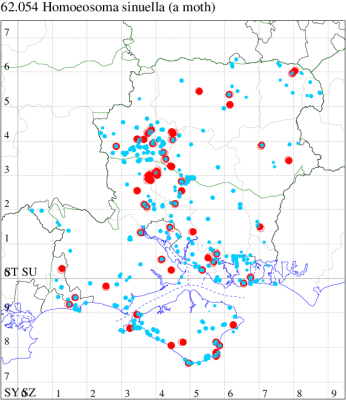
Records by year
Records by week (adult)
Records by week (larval)
Record Summary
VC10: Earliest: Bonchurch Down, 09 May, 1 (IOu) Latest: West High Down Quarry, 20 Aug, 2 (IOu) Max count: Bonchurch, 02 Jun, 4 (JHa)
VC11: Earliest: Totton, 19 May, 1 (LH) Latest: Winchester, 21 Aug, 1 (THW) Max count: Twyford, 15 Jun, 4 (RJD)
VC12: Earliest: Over Wallop, 21 May, 1 (CM) Latest: Chilbolton, 15 Sep, 1 (GCE) Max count: Basingstoke, 23 Jun, 6 (RHil)
62.055 [B&F: 1480] Homoeosoma nebulella ([Denis & Schiffermüller], 1775) - Nationally Scarce B
Nationally scarce (Nb) on rough ground throughout much of southern England, north to Yorkshire. Rather uncommon in Hampshire and on the Isle of Wight, where recorded in most years, mainly from the western chalk and south-east. Wingspan 20-27 mm. Usually larger than Phycitodes binaevella, though a more delicate-looking insect, and characterised by the pale coloration, weak markings, and above all by the dark shadow along the outer-half of the costa of the forewing [Goater]. Larva feeds within flowerheads of Spear Thistle.
Records prior to 2020
| Vice County | #Records | #Individuals | First Record | Last Record |
|---|---|---|---|---|
| 10 | 13 | 6 | 1856 | 2007 |
| 11 | 63 | 64 | 1973 | 2018 |
| 12 | 23 | 21 | 1951 | 2019 |
2020 records
| Vice County | #Records | #Individuals | Max Quantity |
|---|---|---|---|
| 10 | 2 | 2 | 1 |
| 11 | 2 | 1 | 1 |
| 12 | 1 | 1 | 1 |
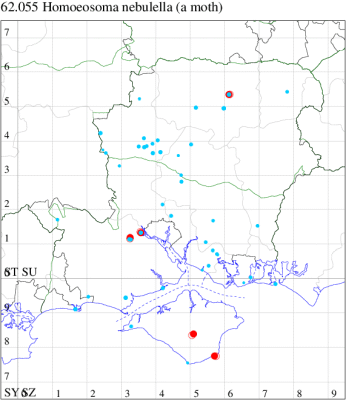
Records by year
Records by week (adult)
Records by week (larval)
Record Details
VC10: Wheelers Bay, one, 08 Aug (ABu); Rookley, one, 08 Jun (JBa);
VC11: Woodlands, New Forest, present, 11 Aug (RBW); Totton, one, 08 Aug (LH);
VC12: Cholderton, two, 08 Aug (TJN, HE); Basingstoke, one, 26 Jun (MJW)
62.057 [B&F: 1485] Phycitodes maritima (Tengström, 1848) - Local
Local in rough meadows and waste ground throughout much of England, especially in the south-east, and also in the Scottish Highlands. In Hampshire and on the Isle of Wight under-recorded and confusable with the other Phycitodes species, and has been bred on several occasions from the heads of Common Ragwort, from both coastal and inland localities - despite its specific name, it is not tied to the coast. Wingspan 18-22 mm. This species is intermediate in size between P. binaevella and P. saxicola, is shorter-winged than the former and more robust than the latter; its spot pattern resembles that of P. saxicola, though the slightly different positioning of the two discal dots does seem to be fairly constant [Goater]. Larva feeds within flowerheads of Yarrow, Tansy, Groundsel and Common Ragwort.
Records prior to 2020
| Vice County | #Records | #Individuals | First Record | Last Record |
|---|---|---|---|---|
| 10 | 15 | 11 | 1900 | 2018 |
| 11 | 371 | 386 | 1951 | 2019 |
| 12 | 39 | 35 | 1951 | 2018 |
2020 records
| Vice County | #Records | #Individuals | Max Quantity |
|---|---|---|---|
| 11 | 3 | 3 | 1 |
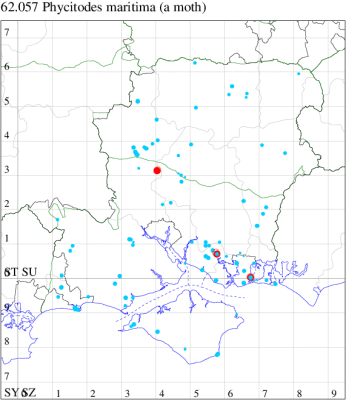
Records by year
Records by week (adult)
Records by week (larval)
Record Details
VC11: Kings Somborne, one, to actinic, 08 Sep (GCE); Fareham, one, gen det, 09 May (KJW det. RJD); Portsmouth, one, 24 May (IRT)
62.058 [B&F: 1483] Phycitodes binaevella (Hübner, [1813]) - Common
Common in rough ground and meadows throughout England and Ireland. Widespread and fairly common in Hampshire and on the Isle of Wight. Wingspan 22-27 mm. This easiest of the Phycitodes to identify, more robust than its congeners and more strongly marked, with the three dots well-developed and characteristically placed [Goater]. Larva feeds within flowerheads of Thistle, Tansy and Mugwort.
Records prior to 2020
| Vice County | #Records | #Individuals | First Record | Last Record |
|---|---|---|---|---|
| 10 | 98 | 106 | 1893 | 2019 |
| 11 | 445 | 447 | 1951 | 2019 |
| 12 | 258 | 286 | 1951 | 2019 |
2020 records
| Vice County | #Records | #Individuals | Max Quantity |
|---|---|---|---|
| 10 | 11 | 16 | 3 |
| 11 | 9 | 10 | 2 |
| 12 | 13 | 14 | 2 |

Records by year
Records by week (adult)
Records by week (larval)
Record Details
VC10: Freshwater Cliffs, one, 09 Jul; two, 09 Aug (SDa); Shippards Chine, Compton Bay, three, 16 Jul; Brook, three, 16 Jul (IOu); Kingston, one, 01 Jul (ENes); Bonchurch, one, 20 Jun; one, 13 Jul (JHa); Shanklin, one, 25 Jun; one, 14 Jul; one, 16 Jul; Shanklin Upper Chine, one, 02 Jun (IOu);
VC11: Totton, one, 13 Jun (LH); Stanbrige Earls, one, to actinic, 08 Jul (JRMi); Winchester, two, 07 Jul (THW); Fareham, one, 25 May (ADT); Hilltop, The Hangers, one, 01 Aug (SI); Portsmouth, one, 23 Jun; one, 29 Jul (IRT); Pennington, one, 10 Aug (RFC);
VC12: Over Wallop, one, 27 Aug (CM); Cholderton, one, 24 Jul (TJN, HE); one, field observation, 11 Aug (TJN, LF); Chilbolton, one, to actinic, 01 Jun; Goodworth Clatford, one, to actinic, 16 Aug; Wherwell, one, to actinic, 29 Jul; Harewood Forest, one, to actinic, 24 Jun; Barton Stacey, two, to actinic, 12 Jul (GCE); Harestock, one, to actinic, 21 Jun (GRog); Barton Stacey, one, to actinic, 16 Jul; one, to actinic, 16 Jul; one, to actinic, 16 Jul (GCE); Basingstoke, one, 24 Jun (MJW); one, 12 Jul (RHil); Warren Hill, Liss Forest, one, 04 Jul (RJM); Farnborough, one, 23 Jul (KBW)
62.065 [B&F: 1474] Ephestia woodiella Richards & Thomson, 1932 - Local
Local in gardens and farmland throughout much of southern England. An outdoor species compared to other Ephestia species recorded in Britain, except E. elutella, which tend to be very rare pests of warehouses and stored food. In Hampshire and on the Isle of Wight widespread and common, but being nondescript, it is almost certainly under-recorded. Wingspan 14-20 mm. One of six very similar species of Ephestia found in the UK, which are reliably separable only by dissection of the genitalia: however the overwhelming majority of wild-caught individuals that have been critically examined have proved to be the current species, with the other five species being very rare or favouring warehouses. Larva feeds on detritus, dead leaves and dry vegetable matter.
Renamed woodiella (Richards & Thomson, 1932) in the ABH 2019 UK checklist update. Formerly known as Ephestia parasitella spp. unicolorella, it was then raised to specific status as Ephestia unicolorella. In Leraut (2014) the species was split into three, with unicolorella being listed as a distinct species known only from Turkey and Spain. Records previously assigned to parasitella or unicolorella are amalgamated here.
Update: January 2021 (taxonomy)
Records prior to 2020
| Vice County | #Records | #Individuals | First Record | Last Record |
|---|---|---|---|---|
| 10 | 63 | 95 | 1951 | 2019 |
| 11 | 2413 | 4691 | 1951 | 2019 |
| 12 | 309 | 471 | 1951 | 2019 |
2020 records
| Vice County | #Records | #Individuals | Max Quantity |
|---|---|---|---|
| 10 | 22 | 39 | 6 |
| 11 | 154 | 312 | 12 |
| 12 | 16 | 17 | 2 |
Records by year
Records by week (adult)
Records by week (larval)
Record Summary
VC10: Earliest: Sandpit Copse, 20 May, 1 (IOu) Latest: Shanklin, 23 Aug, 1 (IOu) Max count: Shanklin, 02 Jun, 6 (IOu)
VC11: Earliest: Southsea, 24 Apr, 1 (JRL) Latest: Southsea, 12 Aug, 1 (JGe) Max count: Southsea, 01 Jun, 12 (JRL)
VC12: Earliest: Yateley, 09 May, 1 (JHH) Latest: Yateley, 12 Aug, 1 (JHH) Max count: Yateley, 26 May, 14 (JHH)


()(IMG_4597).jpg)



()(IMG_5304).jpg)